The winners of Archinect's "Dry Futures" competition are revealed!
By Bustler Editors|
Wednesday, Sep 16, 2015
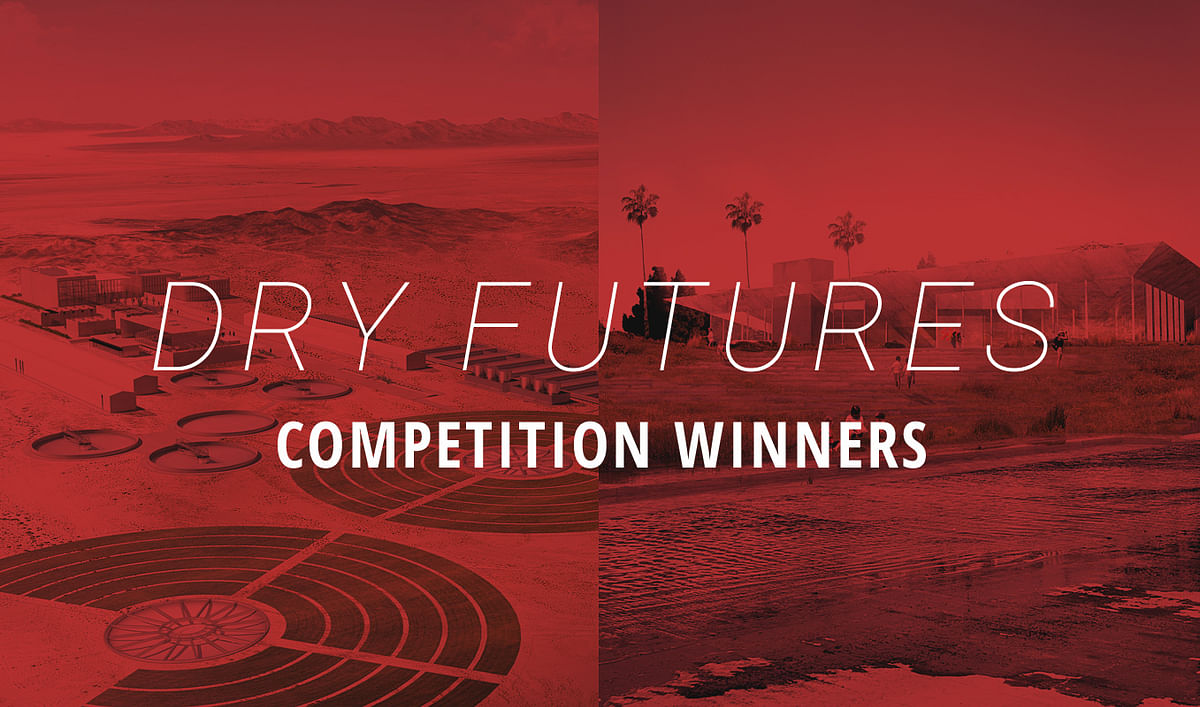
Related
Bustler and our sister site Archinect are pleased to announce the winners of the Dry Futures competition! As California's historic drought wears on, the demand to find viable solutions to help alleviate arid conditions is no easy task. However, the global architecture community is equipped with a broad range of skills and tools to respond to this complex issue in forward-thinking ways.
Read on for more.
Launched earlier this summer, we asked participants worldwide to send their most inventive design ideas that address the California drought — from practical and idealistic to speculative and maybe even dystopic. Entrants had the choice to submit a Pragmatic or Speculative response.
After careful deliberation, the competition jury selected three winners for each category. The prizes include cash and some nifty custom survival-kits — generously provided by a group of reputable brands — that might just come in handy someday.
Get a glimpse of the winning entries below:
SPECULATIVE CATEGORY WINNERS
1ST PLACE: Grassroots Cactivism
By Ali Chen
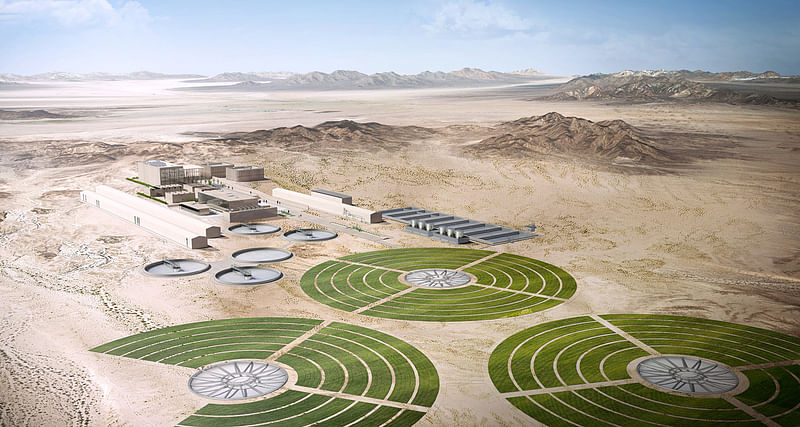
Project description: "California is entering the fourth year of an epic drought. Urban households have reduced water usage by 25%. However, legislation does not apply to farmers, while 80% of the state's water usage goes towards agricultural production. A large percentage of that water goes towards crops that feed livestock. Efforts to conserve water need to target these water-intensive aspects of the farming industry.
California's unique arid and mediterranean climate plays host to a variety of indigenous species. Among these is the drought-tolerant nopales cactus, otherwise known as the prickly pear. It has existed as a food source in local culinary traditions for many centuries, and is also commonly used as fodder for livestock in times of drought.
There is another lesser-known use of the nopales: its pulp acts as a cleaning agent for water. Locals in Mexico have often dumped the water used to cook cactus into polluted rivers and streams. The 'mucilage' or inner cactus pulp has also been tested and used in oil spills. Cactus pulp was found to disperse crude oil efficiently at much lower concentrations than synthetic dispersants.
At our cactus farm we propose to use this low-tech solution to improve and revolutionize existing wastewater management systems, as well as mitigate water usage in farming by supplying a crop that requires little to no water. As a hardy plant that grows locally, this cactus farm can be located anywhere in California. However, it is ideal to locate it near an existing reservoir for convenient releasing of purified water.
A portion of the cactus grown at the farm will be harvested and distributed for human consumption. The pulp of another portion of the crop will go directly into the bio-reactors at the on-site wastewater purifying plant, while the remainder will be hand-processed into fodder for distribution within California and as well as exported.
The farm will not only be a local attraction, it will aim to attract visitors from all over by hosting an eco-resort marketed towards the health-conscious modern traveler, with cooking workshops, highly-rated fine dining, a water museum, and various resort amenities. The goal is to market the use of cacti in contemporary cuisine, grow awareness, provide funding for research, and slowly increase demand for a crop that can eventually replace other water-intensive forms of vegetable and fodder."
2ND PLACE: Urban Swales: Subterranean Reservoir Network for Los Angeles
By Geofutures @ Rensselaer School of Architecture Muhammad Ahmad Khan (student), Chris Perry (program director) & Ted Ngai, Fleet Hower, Kelly Winn, Lydia Xynogala (program faculty)
Acknowledgements: Evan Douglis, dean of the Rensselaer School of Architecture
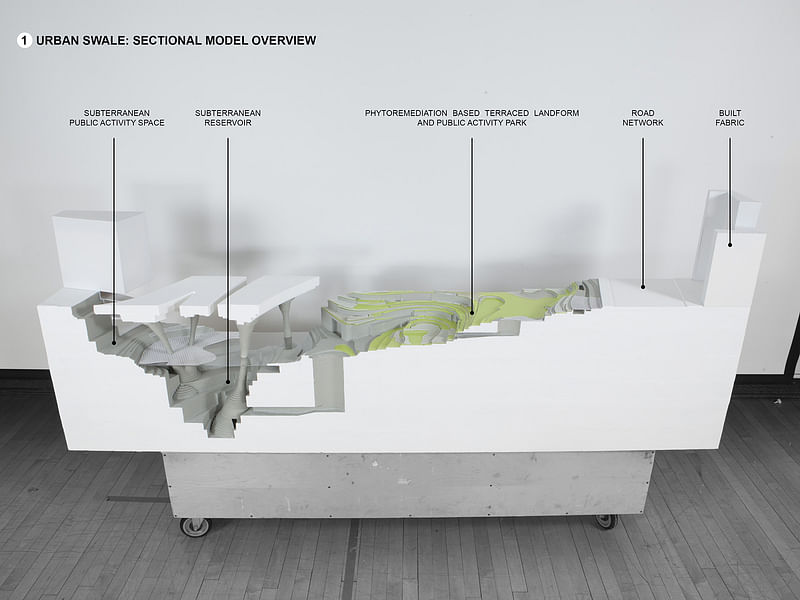
Project description: "Geofutures: Fifteen years ago, Nobel Laureate Paul Crutzen announced that the world had entered a new geological age, what he termed the Anthropocene, a period characterized by industrial anthropocentrism as a new geophysical force on Earth. The principle qualities and conditions of this new age, namely those of global warming, mark a fundamental shift in human-nonhuman relations, the end of one world and the beginning of another, in which human social, psychic, and philosophical space has been infiltrated by a nonhuman presence, bringing with it a new period of environmental anxiety and existential uncertainty.
The Geofutures Post-Professional Program at Rensselaer Polytechnic Institute’s School of Architecture seeks to engage this new period of environmental anxiety and existential uncertainty by posing the question as to whether architecture should embark on establishing new affiliations beyond the human; a fundamental realignment of the discipline as something no longer significant for ‘us’ alone. In doing so, the program endeavors to convert crisis into opportunity by harnessing both the pressures of a planet at risk and the promise of emerging environmental technologies to generate a broad spectrum of possible, if not probable, urban and architectural futures for the twenty-first century.
Urban Swales: Urban Swales proposes a series of medium-scale urban excavations throughout the City of Los Angeles, micro-reservoirs that, in addition to collecting periodic storm water runoff for remediation, storage, and redistribution to local communities, provides a new typology of shaded “urban caverns” for human as well as nonhuman forms of occupation. As such, Urban Swales not only functions as a distributed form of water management infrastructure, the general ambition of which is intended to relieve the city’s excessive dependence on imported water, but a new form of public space and wildlife refuge as well.
Located at select intersections throughout the city, these “swales” tap into the street grid’s existing drainage infrastructure, effectively harnessing the urban fabric as an underutilized watershed for the collection and distribution of runoff. Storm water enters each swale at the street corners where it is temporarily stored before beginning its gradual descent down through a cascade of phytoremediation terraces. These terraces support plant life necessary for the various stages of water filtration, but also provide for human inhabitation through a “programmatic mat” of lightweight grating that serves as a walking surface. Additionally, the terraces encourage biodiversity among an extended ecology of insects, birds, and small animals, activating the swale as a refuge for wildlife.
Urban Swales subverts the conventional quest for water as an act of drilling wells into the landscape. Rather than excavating and tapping into existing water reserves or aquifers, it instead activates the potential of dormant urban hydrologies. The new subterranean datum is carved into the urban fabric of LA; irrigated from within and diverting water out into the city networks. With time the “swales” not only become a fertile and lush ground but a new water source for the city."
3RD PLACE: "Analogue Sustainability: 'The Climate Refugees of San Francisco'
By Rosa Prichard
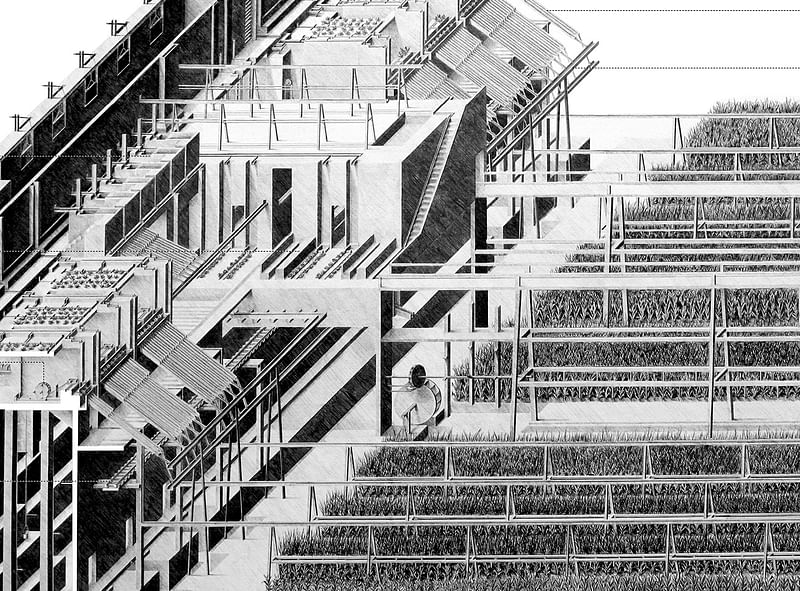
Project description: "The project is sited on Treasure Island in San Francisco Bay. The scheme tackles the Californian paradox of too much vs too little water. While the area is in a state of drought, San Francisco Bay is still at risk of flooding both from seasonal heavy rainfall and rising sea levels. The project is an inhabited flood defence wall that wraps around the island, housing those displaced by rising sea levels in the bay. A field condition of maize is planted over the island to draw out the radiation remaining from the island’s naval occupation. The island becomes a self-sustaining system, where analogue technologies that hark back to industrial mechanisms are used. The island offers a celebration of a more simple and natural way of life, in contrast to that of San Francisco and Silicon Valley.
Sustainable systems of water purification and energy production become central to the building. The burning of the maize provides bio-fuel while rain water catchment provides water. Even in California - a region prone to draught - enough rain water can be harvested and stored throughout the year, and enough energy can be harnessed from bio-fuels to provide for the proposed 2000 inhabitants of the island. The process of natural water purification is articulated through the architecture of the wall, creating a spectacle of water.
The building acts as a sanctuary where climate refugees can mourn the loss of their home while also reassessing their values and the realities of climate change - how can we be more efficient with our resources - using them to improve our own lives without depleting them? The inhabitants will develop an understanding and an inherent respect for our most precious resources - water and energy - that they can take back with them to the mainland.
The project seeks to move away from the understanding of sustainability as something that constrains us; merely something that we ‘ought‘ to do, to something creative, generous and genuinely life enhancing. Through this new proposed system, we still learn how to use resources efficiently, but we also learn to sanctify and celebrate them. The building becomes a cathedral to our precious resources, where nothing is taken for granted; not a cubic mm of water and joule of energy is wasted. All is reintroduced into the interconnected virtuous cycle of the island."
PRAGMATIC CATEGORY WINNERS
1ST PLACE: Liquifying Aquifers
by Lujac Desautel
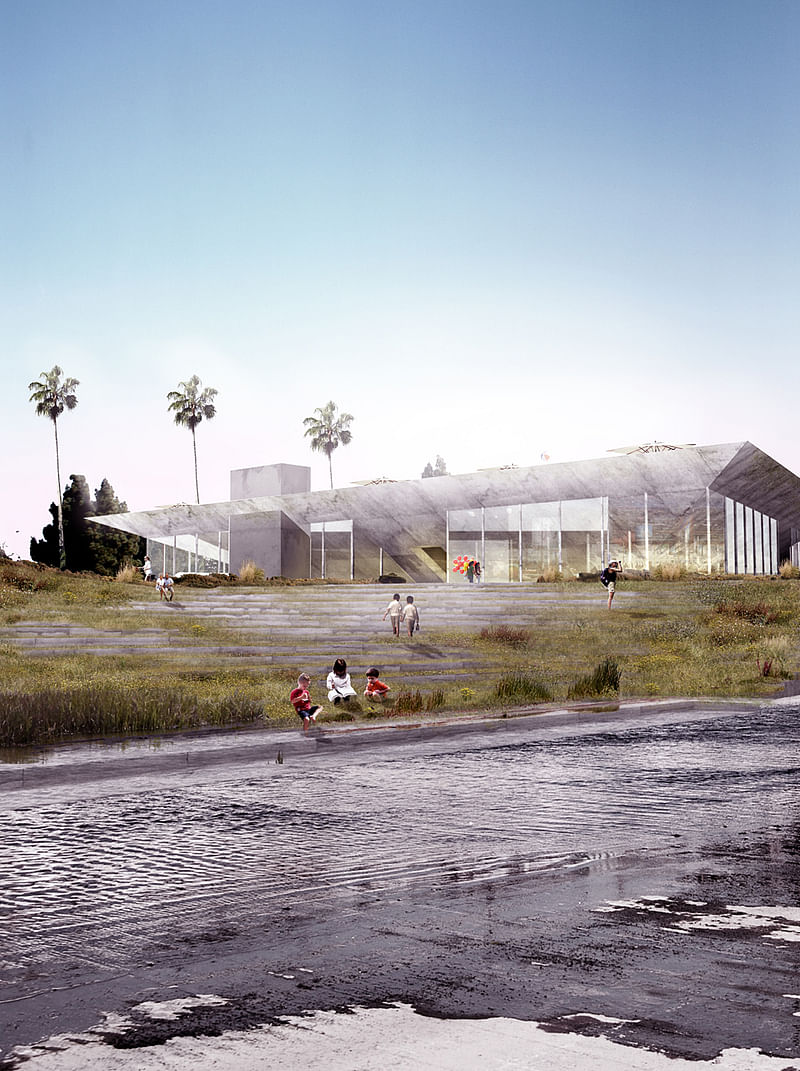
Project description: "The story of water in the San Fernando Valley is the by-product of the American frontier to the West and the seemingly unattainable ambitions to protect the mythicized image of lush palm trees and turquoise swimming pools. But, the illusion of water is on the cusp of extinction. The San Fernando Valley is conceptualized as an archipelago of islands characterized by the infrastructures that sever its own territories. In between these forgotten corridors are the conduits, transportation networks, and energy easements that are a crutch to the livelihood of the Valley. The largest of these corridors, the Tujunga Wash cuts the valley in half by a 13 mile artificial river that sends every drop of water to the Pacific Ocean. Its adjacencies are anything but monotonous, rich, poor, industrial, mega malls, and the endless repetition of four-way intersections.
The San Fernando Groundwater Basin sits 40 feet below the surface, continually being over withdrawed by a water hungry city without any large-scale plan to replenish this invaluable commodity. As population growth continues to rise, there will be less space and more hardscapes and a significant amount of runoff water which will go unused unless harnessed by a strategic system that works within the existing urban conditions of infrastructures, easements and parking lots.
What if the Valley could have multiple drains placed around the city in contingent locations for maximum water replenishment back into the Aquifer? Like a giant bathtub with a conglomerate of drains! The symbiosis of Liquifying Aquifers through public domain and water infrastructure aims to localize aquifer replenishment and operate to community specific needs."
2ND PLACE: Liquid Bank
By Juan Saez

Project description: "Liquid Bank confronts California’s drought from both a local and global perspective. The project addresses the relationship between domestic water consumption and the global water crisis with the development of water related infrastructure in emerging countries. Ultimately, the project aims to address California’s drought emergency situation by causing a behavioral shift amongst California residents.
Liquid Bank is a platform (app and website) that offers a system of rewards and incentives that encourage users to use water responsibly in both their domestic and corporate life. Users sign-up for a profile at LiquidBank.com and begin earning the Liquid Bank’s digital currency, Aquo.
Users can earn Aquos through implementing a variety of water-saving habits: installing low flow shower heads or faucet aerators, incorporating container gardening or drought resistant plants, reducing their household water bill or, as an enterprise, developing a plan to improve an office’s water consumption habits.
Depending on the water saving impact of the action in gallons per month, a certain amount of Aquos will be added to the users account. As users earn Aquos, they support water-related infrastructure projects in developing countries. Members of the Liquid Bank feel a greater incentive to save water because of the direct ability to be a part of behavioral change, aid the drought, and create global water consumption awareness.
Aquos can be exchanged for projects that positively affect water supply and sanitation in developing countries. Users (person or enterprise) can become sponsor water-related humanitarian action. This way, with just one simple action, the Liquid Bank creates change both in simultaneously in developing countries where there is not enough water infrastructure and in California, where water consumption must be reduced."
3RD PLACE: Recharge City
By Barry Lehrman

Project description: "Recharge City evaluates pragmatic options for recharging the groundwater in Los Angeles County by recycling the 502 million gallons of water that is dumped by Hyperion Treatment Plant and the Joint Water Pollution Control Plant into the Pacific each day. This is enough water to quench the thirst of 5 1/2 million people.
To identify plausible sites for recharge, this project undertook a holistic mapping of the water infrastructure for the metropolis - ultimately collecting data from over 50 local, state, and federal agencies.
Recycling water is a necessity for Southern California to survive, so how can this massive infrastructure project to close the water loop create a better city for us to live in?"
Jury:
- Allison Arieff (Editorial Director of SPUR)
- Charles Anderson (Founder/Principal of WERK)
- Geoff Manaugh (Founder of BLDGBLOG)
- Hadley and Peter Arnold (Co-Founders/Directors of the Arid Lands Institute)
- Jay Famiglietti (Senior Water Cycle Scientist at the Jet Propulsion Laboratory)
- Peter Zellner (Principal and Design Lead at AECOM, Los Angeles)
- Colleen Tuite and Ian Quate (Co-Founders of GRNASFCK)

Share
0 Comments
Comment as :